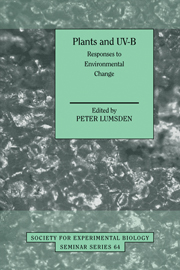Book contents
- Frontmatter
- Contents
- List of contributors
- Preface
- PART I The ozone layer and UV-B radiation
- Global ozone depletion: observations and theory
- Monitoring changes in UV-B radiation
- Action spectra for UV-B effects on plants: monochromatic and polychromatic approaches for analysing plant responses
- PART II Effects of UV-B on plants at the cellular level
- PART III Effects of UV-B at the whole plant and community level
- Index
Monitoring changes in UV-B radiation
Published online by Cambridge University Press: 04 August 2010
- Frontmatter
- Contents
- List of contributors
- Preface
- PART I The ozone layer and UV-B radiation
- Global ozone depletion: observations and theory
- Monitoring changes in UV-B radiation
- Action spectra for UV-B effects on plants: monochromatic and polychromatic approaches for analysing plant responses
- PART II Effects of UV-B on plants at the cellular level
- PART III Effects of UV-B at the whole plant and community level
- Index
Summary
Introduction
The biological consequences of ozone depletion, mediated through an increase in ultraviolet-B (UV-B) radiation, have been cause for concern, prediction and speculation for many years. Estimating the potential effects of ozone depletion involves several steps:
Estimating the ozone depletion that might realistically be expected over a given region of the world (this requires assumptions about, for example, compliance with the Montreal Protocol, or not). Alternatively, observed ozone depletions to date can be used to assess the changes already experienced.
Calculating changes in UV-B due to changes in ozone. The assumption is that all else remains unchanged and these calculations are usually made for clear-sky conditions. If changes in UV-B irradiances have been observed, then they may be used instead, but they cannot necessarily be attributed solely to changes in ozone.
The exposure of biological systems to the available UV-B must be assessed. For plants growing at a single location, this can be assumed to remain unchanged, but for mobile systems (animals, fish, and especially people) adaptive behaviour is possible.
The biological (or chemical) results of exposure to the (changed) UV-B must be predicted, based on experiment and observation. Response may depend upon accumulated dose, upon reaching some threshold dose, and upon possible protective mechanisms, for example, the build-up of UV-absorbing pigments (melanin in humans, flavonoids in plants).
- Type
- Chapter
- Information
- Plants and UV-BResponses to Environmental Change, pp. 13 - 30Publisher: Cambridge University PressPrint publication year: 1997
- 19
- Cited by

